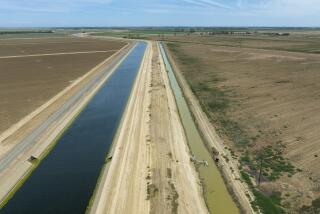Truce--and Victory : Now reformers must avoid refighting the water wars
- Share via
Most Californians can celebrate President Bush’s decision last week to sign legislation that alters the way this state’s federal water is distributed--even if, in the end, election year politics was more important to the President than water reform.
It is not insignificant that Bush signed the Western water package, HR 429, aboard Air Force One while campaigning. The bill is a classic case of pork barrel politics, and contains water projects for 16 Western states. And with the exception of California, where public opinion polls indicate Bush is trailing Gov. Bill Clinton, most of the West is up for grabs in the presidential race.
So despite objections from some California farmers and political leaders like Gov. Pete Wilson and Sen. John Seymour, both fellow Republicans, Bush signed a bill that allocates $922 million to complete the Central Utah Project, gives Arizona more control of the Colorado River’s flow in order to protect the Grand Canyon, and so on.
With so much in it for almost everyone west of the Rockies, it is surprising that Wilson got Bush to even consider a veto. Wilson flew cross-country on Friday to meet with the President and try to convince him to kill the measure. Take that as a sign of just how much clout big farmers out here can muster when they need to.
Growers are unhappy with the new law’s provisions that loosen their grip on the federal Central Valley Project, which controls 20% of the developed water in this state. CVP, built by the federal government starting in 1935, is one of the two major water systems that brings water from Northern California to the arid San Joaquin Valley and Southern California. But because of outdated federal rules most of that water had to be sold in the Central Valley, at subsidized prices and under 40-year contracts, for use on farms.
Now it can be sold, at market prices, to California’s fast-growing cities, which have been desperately looking for new water supplies due to a seven-year-long drought. In the old days new supplies would have meant new dams on far-flung rivers, and new canals to bring the water south and new reservoirs to store it until needed. But government no longer has the money for mega-projects like that. So water officials have begun looking for ways to use more efficiently the developed water resources California already has. CVP was a logical, and necessary, target for reform.
Leading the reform campaign were Rep. George Miller (D-Martinez) who had been trying for many years to make CVP water available for urban use and for environmental protection. His counterpart in the Senate was New Jersey Democrat Bill Bradley. But they were aided along the way by representatives of both farm and environmental groups who were willing to look beyond short-term interests and find practical solutions to California’s long-term water needs. They succeeded admirably.
The challenge facing California now is to not let the bitter political water fight of the last few months spill over, so to speak, onto other water reforms that are also needed. For example, Wilson wants the state to eventually take over CVP and run it in coordination with California’s other big water system, the State Water Project. That worthwhile proposal should be taken up in the very next session of Congress. But it will happen only if all the parties involved look ahead instead of trying to refight the water wars of the past.
More to Read
Get the L.A. Times Politics newsletter
Deeply reported insights into legislation, politics and policy from Sacramento, Washington and beyond. In your inbox twice per week.
You may occasionally receive promotional content from the Los Angeles Times.










